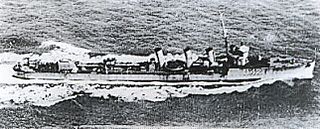Several ships of the Royal Navy have been named HMS Onslaught:

The Royal Navy (RN) is the United Kingdom's naval warfare force. Although warships were used by the English kings from the early medieval period, the first major maritime engagements were fought in the Hundred Years War against the Kingdom of France. The modern Royal Navy traces its origins to the early 16th century; the oldest of the UK's armed services, it is known as the Senior Service.
- HMS Onslaught (1915), an Admiralty M-class destroyer launched in 1915 and sold for scrap in 1921.
- HMS Onslaught (G04), an O-class destroyer launched in 1941. In 1951 she was sold to Pakistan and renamed Tughril. She was scrapped in 1977.
- HMS Onslaught (S14), an Oberon-class submarine, launched in 1961 and served until 1990.

The M class, more properly known as the Admiralty M class, were a class of 85 destroyers built for the Royal Navy that saw service during World War I. All ships were built to an identical - Admiralty - design, hence the class name. 18 other vessels which were officially included within the 'M' class were built to variant designs by three specialist builders - 10 by Yarrow, 6 by Thornycroft, and 2 by Hawthorn Leslie; however, these are listed in other articles.

In naval terminology, a destroyer is a fast, maneuverable long-endurance warship intended to escort larger vessels in a fleet, convoy or battle group and defend them against smaller powerful short-range attackers. They were originally developed in the late 19th century by Fernando Villaamil for the Spanish Navy as a defense against torpedo boats, and by the time of the Russo-Japanese War in 1904, these "torpedo boat destroyers" (TBDs) were "large, swift, and powerfully armed torpedo boats designed to destroy other torpedo boats". Although the term "destroyer" had been used interchangeably with "TBD" and "torpedo boat destroyer" by navies since 1892, the term "torpedo boat destroyer" had been generally shortened to simply "destroyer" by nearly all navies by the First World War.

HMS Onslaught was an O-class destroyer of the Royal Navy which entered service in 1941. She was originally to have been named Pathfinder, but this was changed during construction. She was adopted by the Isle of Wight as part of the Warship Week campaign in 1942. After the Second World War she was sold to Pakistan and scrapped in 1977.
| This article includes a list of ships with the same or similar names. If an internal link for a specific ship led you here, you may wish to change the link to point directly to the intended ship article, if one exists. |
